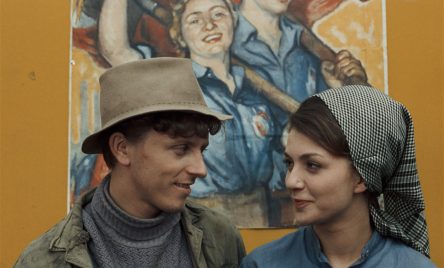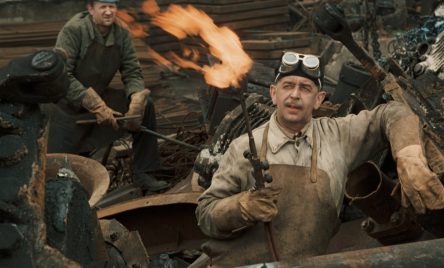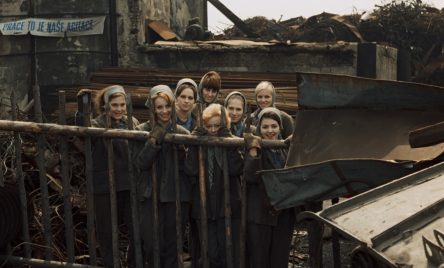“Adapting Hrabals’ stories, director Jiří Menzel skilfully creates the illusion that the communists managing the Kladno steelworks, just like other functionaries commuting to the steelworks, are predominantly incompetent people whose actions are based not on their conviction but rather on careerism.”[1]
This was the reasoning behind banning Jiří Menzel’s Larks on a String (Skřivánci na niti, 1969). Unlike other films banned for political reasons during the Normalisation era, this film wasn’t even premiered in the cinemas. According to Jaromír Blažejovský’s terminology, this is an example of a primary “vault” film. Secondary “vault” films were screened at least for a short time before being banned.[2]
Menzel didn’t expect such intervention. He didn’t perceive himself as an author of politically delicate works. “I had no artistic ambitions,” he told Jan Lukeš in an interview.[3] He believed that – just like flexible craftsmen such as Otakar Vávra and Martin Frič – he would be able to make one film after another at a brisk pace. During the production of Larks on a String, he saw the film as a mere “humorous warning about the foolishness of the 1950s”.[4] But instead of receiving another job offer, he was banned from making films for several years.
Not even the preparatory phase in autumn 1968 had indicated that there would be trouble. After The Death of Mr. Balthazar (Smrt pana Baltazara, 1965) and Closely Watched Trains (Ostře sledované vlaky, 1966), the film combining motifs of four stories from the anthology An Advertisement for the House I Don’t Want to Live in Anymore (Inzerát na dům, ve kterém už nechci bydlet, 1965) was Menzel’sthird collaboration of the acclaimed director with writer Bohumil Hrabal.
The assessments of the literary script that Menzel wrote together with Hrabal were very favourable and, except for partial reservations, recommended the realisation of the project. Zdeněk Mahler, for instance, praised the story of social outcasts, assigned by the regime in the 1950s to the Kladno steelworks,[5] for its “plebeian surrealism”. Also other assessors expressed hope that the combination of Menzel’s poetic approach with Hrabal’s naturalism would create another poetic testament of the tragedy of the time, which “wanted to be grand, but is cruel and ridiculous instead”.
The ideologic-artistic committee of the Juráček-Kučera creative group approved the shooting script on 17 December 1968. As early as in September that year, the producers held talks with foreign partners about a possible co-production. Menzel, and cinematographer Jaromír Šofr, respectively, wanted to use high-quality West-German colour film stock Eastmancolor, which was a scarce commodity in Czechoslovakia, and Barrandov Studio had only limited foreign currency resources for purchasing it.
Originally, negotiations were held with Greek-Italian producer Moris Ergas, who had previously financed for instance Juraj Jakubisko’s The Deserter and the Nomads (Zbehovia a pútnici, 1968). But an agreement wasn’t reached, and Barrandov turned to the Munich-based company Betafilm instead. The company procured the film stock, invested 50,000 dollars and secured distribution rights for Europe (excluding the Soviet Bloc countries). The banning of the film naturally meant complications for fulfilling the contract.
Apart from a denouncement by a Kladno steelworks employee that an anti-state film was being filmed there, the filming at the site went smoothly, with the full support of the management of the state-controlled film industry. “We filmed Larks at the very beginning of the Normalisation period in 1969, when the normalisers were unable to ban films because of their scripts,” head of production Karel Kochman explained many years later.[6]
Problems arose after the film was finished. Even though Menzel didn’t intend his film in this manner, the new Barrandov Studio management perceived it as a direct attack on the absurdity of socialist reality. In October 1969, Jiří Purš, the new director of Czechoslovak State Film, didn’t give the film his approval. The new management’s verdict was also negative. Purš explained his decision with the following words: “From generally humanist principles, the film in broader context questions the principle of collectiveness and satirises the changes made after February 1948 and the whole process of building socialism.”[7]
There was still hope, however, that after some cuts, Larks on a String could still make it into distribution. Representatives of Betafilm, who saw a copy of the finished film in the fall of 1969, were satisfied with it. Menzel’s colleagues also praised the film. “Those who have seen it claim it to be Menzel’s best work,” Josef Škvorecký remarked in early 1970s.[8] Škvorecký’s words are confirmed by later reactions. According to critics, Menzel managed to streamline Hrabal’s layered work and shape it into a smooth narrative aptly naming social circumstances.
Hrabal’s story fit among cinematic and literary works which during the period of cultural liberalisation offered a sober critical look on the builder ethos of the preceding decade. The satirical story takes places at the Kladno steelworks scrapyard, which served as a labour / re-education camp for individuals who didn’t submit to the norms of the communist society and representatives of defeated and officially dispersed classes. The film begins with a union deputy bringing along a filmmaker who wants to use the workers for his agitprop.
The filming is interrupted by a strike. A seemingly disparate group is formed by a procurator believing in the independence of law from politics, a free-thinking professor of philosophy, an Adventist refusing to work on Sunday, and a saxophonist playing decadent imperialistic jazz. In addition to this male group, the scrapyard also employs “hill girls,” girls and women who unsuccessfully tried to cross the country’s mountainous western borders.
These social outsiders, sentenced because of their faith or convictions to inferior manual labour, form a paradoxical collective hero who refused or was unable to adapt to a collective and is now, like an exotic animal doomed to extinction, presented to the Young Pioneers. But in the inhospitable environment full of scrap metal, these “enemies of the state” formed a parallel state based on reconciliation, understanding and equality, the same principles promoted but not upheld by the Communist party during the era of Stalinism.
Unlike many of their contemporary colleagues, Hrabal and Menzel didn’t perceive the 1950s as a time of absolute darkness with nothing but denunciations, cruel interrogations and political persecutions. Despite the seeming hopelessness of the situation, grey colours, shabby clothes and the impossibility to get justice, the authors accentuate in particular the kind and humorous moments and the ability of palavering heroes to face obtusely dogmatic socialism and increasing totalitarian pressure. With love, friendship and poetic language. With the chosen grotesque stylisation, the film fittingly portrays the intended distribution tagline ironically poking at the class-conscious socialism-building films from the 1950s: “A colourful fairy-tale about building our country.”
At the request of the Normalisation-era censorship committee, the authors had to cut out a socialist song, change the opening credits and many dialogues and delete a scene involving a police officer and a bathing gypsy woman. A particular thorn in their side was a scene in which the steelworks are visited by a tall and senile party official, evidently alluding to a former minister of education and culture, Zdeněk Nejedlý.[9] Menzel filmed two scenes to replace the “Nejedlý” scene. Editor Jiřina Lukešová hid the parts that had to be cut out. After the Velvet Revolution, they were returned to the film.
But the aforementioned changes had no effect. The film didn’t receive distribution approval for Czechoslovakia or other countries. According to Menzel, Betafilm sued the Czech producers and demanded its money back. The premiere of this “antisocialist, anti-Communist and ani-Soviet” tragicomedy was held in January 1990. Not long after, the film was ceremonially screened at the 40th Berlinale, where it won the Golden Bear together with Music Box by Costa-Gavras. Other festival screenings followed.
For Menzel, it was a partial satisfaction for being put on the blacklist after the events of August 1968 – he was put there because of Larks and his Oscar for Closely Watched Trains. But when he gave an apologetic interview to the magazine Záběr in 1974, he repented mainly for Larks. He said that he wasn’t a competent person to adapt a story from the 1950s and admitted that his lack of forethought and perspective was the biggest mistake while working on the film.[10]
After this self-criticism, Menzel was allowed to film the socialism-building agitprop Who Looks for Gold? (Kdo hledá zlaté dno, 1974) and once again become a reliable employee of Barrandov Studio, just like his mentor, Otakar Vávra.
Martin Šrajer
Notes:
[1] Štěpán Hulík, Kinematografie zapomnění. Praha: Academia 2011, p. 62.
[2] For more on “vaulted” films, see Jaromír Blažejovský, Trezor a jeho děti. Iluminace 22, 2010, no. 3, pp. 8–27.
[3] Jan Lukeš, Jak nastupovala v českém filmu normalizace. III. „To, co dělám, má mít smysl.“ Jiří Menzel od Skřivánků na niti ke Kdo hledá zlaté dno. Iluminace 9, 1997, no. 1, p. 138.
[4] Ibid.
[5] Hrabal knew the place very well as in 1949 he got employed at the Kladno Steelworks.
[6] Š. Hulík, c. d., p. 414.
[7] Dana Čermáková, Pábitel Jiří Menzel. Lipník nad Bečvou: Imagination of People 2010, p. 58.
[8] Josef Škvorecký, Všichni ti bystří mladí muži a ženy. In Josef Škvorecký, Nejdražší umění a jiné eseje o filmu. Praha: Books and Cards 2010, p. 134.
[9] The parody of Nejedlý was portrayed by actor Vladimír Šmeral. Ironically enough, the same actor portrayed Zdeněk Nejedlý almost 10 years later in a socialism-building historical film The Victorious People (Vítězný lid, 1977)
[10] Jiří Hrbas, S Jiřím Menzelem o dnešku i včerejšku. Záběr 7, 1974, no. 17 (16 August 8), p. 3.




